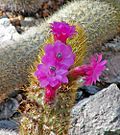Description
Borzicactus icosagonus grows as a shrub with prostrate to creeping or ascending shoots and forms large, low piles. The light green shoots reach a length of 20 to 60 centimeters with diameters of 3 to 5 centimeters. There are 8 to 21 low, rounded ribs, which are divided into cusps by furrows. The areoles on it are close together. Areoles capable of flowering are covered with numerous, fine, long bristles. The 25 to 60 golden yellow thorns are needle-like or bristly and 1 to 1.5 centimeters long.
The almost straight, crooked-edged, pink to scarlet to orange flowers are 7 to 8 centimeters long. Their pericarpel is covered with small scales with a few hairs. The spherical, green to yellow fruits reach a diameter of 2 to 4 centimeters and are often covered with a few hairs. [2]
Subspecies
Accepted subspecies: [3]
| Image | Name | Distribution |
|---|
 | Borzicactus icosagonus subsp. humboldtii(Kunth) G.J.Charles | Peru. |
 | Borzicactus icosagonus subsp. icosagonus | Ecuador to Peru |
 | Borzicactus icosagonus subsp. roseiflorus(Buining) G.J.Charles | Ecuador |
|
This page is based on this
Wikipedia article Text is available under the
CC BY-SA 4.0 license; additional terms may apply.
Images, videos and audio are available under their respective licenses.




